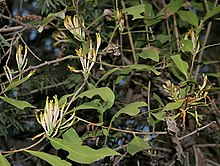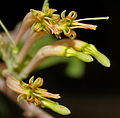
Mistletoe is the common name for obligate hemiparasitic plants in the order Santalales. They are attached to their host tree or shrub by a structure called the haustorium, through which they extract water and nutrients from the host plant.
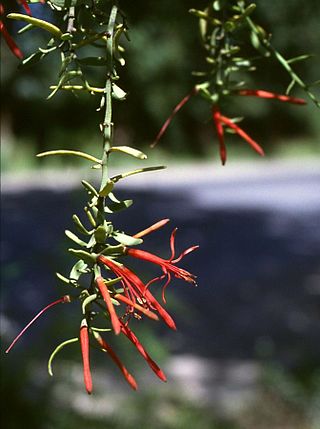
Loranthaceae, commonly known as the showy mistletoes, is a family of flowering plants. It consists of about 75 genera and 1,000 species of woody plants, many of them hemiparasites. The three terrestrial species are Nuytsia floribunda, Atkinsonia ligustrina, and Gaiadendron punctatum Loranthaceae are primarily xylem parasites, but their haustoria may sometimes tap the phloem, while Tristerix aphyllus is almost holoparasitic. For a more complete description of the Australian Loranthaceae, see Flora of Australia online., for the Malesian Loranthaceae see Flora of Malesia.

Delias eucharis, the common Jezebel, is a medium-sized pierid butterfly found in many areas of south and southeast Asia, especially in the non-arid regions of India, Bangladesh, Sri Lanka, Indonesia, Myanmar and Thailand. The common Jezebel is one of the most common of the approximately 225 described species in the genus Delias.

The pale-billed flowerpecker or Tickell's flowerpecker is a tiny bird that feeds on nectar and berries, found in India, Sri Lanka, Bangladesh and western Myanmar. The bird is common especially in urban gardens with berry bearing trees. They have a rapid chipping call and the pinkish curved beak separates it from other species in the region.

Phoradendron is a genus of mistletoe, native to warm temperate and tropical regions of the Americas. The center of diversity is the Amazon rainforest. Phoradendron is the largest genus of mistletoe in the Americas, and possibly the largest genus of mistletoes in the world. Traditionally, the genus has been placed in the family Viscaceae, but recent genetic research acknowledged by the Angiosperm Phylogeny Group shows this family to be correctly placed within a larger circumscription of the sandalwood family, Santalaceae.

The mistletoebird, also known as the mistletoe flowerpecker, is a species of flowerpecker native to most of Australia and also to the eastern Maluku Islands of Indonesia in the Arafura Sea between Australia and New Guinea. The mistletoebird eats mainly the berries of the parasitic mistletoe and is a vector for the spread of the mistletoe's seeds through its digestive system.

Tristerix is a genus of mistletoe in the family Loranthaceae, native to the Andes, ranging from Colombia and Ecuador to Chile and Argentina. They are woody perennials usually occurring as aerial parasites, are pollinated by hummingbirds and flowerpiercers, with seed-dispersal generally by birds but occasionally by mammals (Dromiciops). The genus is distinguished from other New World Loranthaceae by its simple, terminal, racemose inflorescences, together with its of 4- or 5-merous flowers, versatile anthers, and the presence of endosperm. Further differences include fused cotyledons and the absence of epicortical roots.
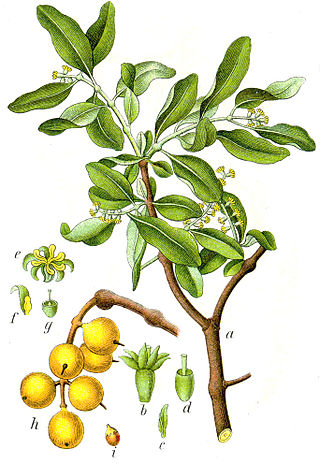
Loranthus is a genus of parasitic plants that grow on the branches of woody trees. It belongs to the family Loranthaceae, the showy mistletoe family. In most earlier systematic treatments it contains all mistletoe species with bisexual flowers, though some species have reversed to unisexual flowers. Other treatments restrict the genus to a few species. The systematic situation of Loranthus is not entirely clear.

Psittacanthus, also parrot-flower, is a plant genus in the family Loranthaceae. It is a type of mistletoe native from central Mexico southwards to Central America and parts of South America.
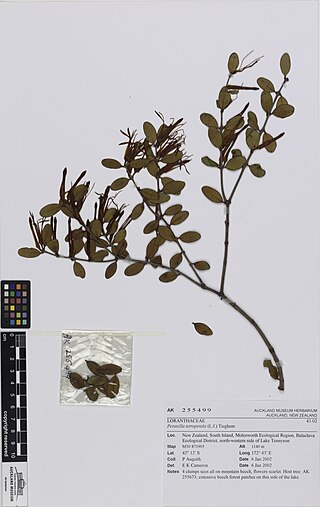
Peraxilla tetrapetala, or red mistletoe, is a parasitic plant in the family Loranthaceae, endemic to New Zealand and found on both the North and South Islands. The Māori names for the plant are pikirangi, pirirangi and roeroe.

Dendrophthoe vitellina, commonly known as long-flowered- or apostle mistletoe, is a hemiparasitic plant of the mistletoe family Loranthaceae. The genus Dendrophthoe comprises about 31 species spread across tropical Africa, Asia, and Australia. Despite being collected by Joseph Banks and Daniel Solander in 1788, and depicted in Banks' Florilegium, it was not until 1860 that it was described by Ferdinand von Mueller as Loranthus vitellinus after being collected near Ipswich, and renamed by Philippe Édouard Léon Van Tieghem in 1895.

Dendropemon is a genus of mistletoes which is endemic to the Caribbean. Members of the genus are hemi-parasites which normally grow on trees and shrubs, although self-parasitism is known to occur. The approximately 31 species range from The Bahamas and Cuba in the north and west, to Barbados and St. Vincent in the southwest. Diversity and endemism is highest on the island of Hispaniola.
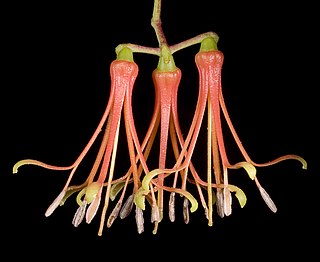
Amyema preissii, commonly known as wireleaf mistletoe, is a species of mistletoe, an epiphytic, hemiparasitic plant of the family Loranthaceae. It is native to Australia where it has been recorded from all mainland states. The flowers are red and up to 26 mm long. The fruits are white or pink, globose and 8–10 mm in diameter. Its habitat is sclerophyll forest and woodland where it is often found on wattles. On Victoria's Bellarine Peninsula its hosts include coast wirilda, golden wattle and drooping sheoak. Its sticky seeds are eaten and dispersed by mistletoebirds.

Lysiana exocarpi, commonly known as harlequin mistletoe, is a species of hemiparasitic shrub, endemic to Australia. It is in the Gondwanan family Loranthaceae and is probably the most derived genus of that family with 12 pairs of chromosomes. The Loranthaceae is the most diverse family in the mistletoe group with over 900 species worldwide and including the best known species in Australia. Mistletoes are notable for their relationships with other species. In an early reference to the group in Australia Allan Cunningham explorer and first Director of the Royal Botanic Gardens, Sydney, wrote in 1817: "The Bastard Box is frequently much encumbered with the twining adhering Loranthus aurantiacus which 'Scorning the soil, aloft she springs, Shakes her red plumes and claps her golden wings'."
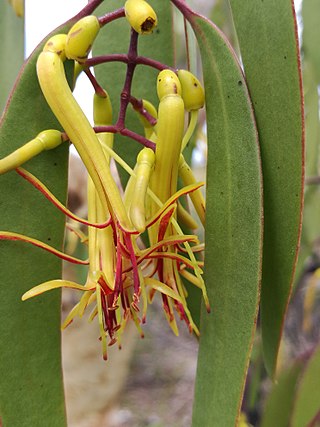
Muellerina is a genus of parasitic aerial shrubs in the family Loranthaceae.

Tristerix aphyllus is a holoparasitic plant species of the genus Tristerix in the family Loranthaceae. It is endemic to Chile. T. aphyllus is sometimes called the "cactus mistletoe." It should not be confused with the mistletoe cactus, which is an epiphytic cactus, and not a mistletoe.
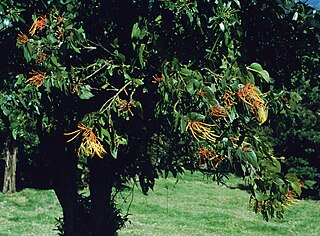
Psittacanthus schiedeanus G.Don is a species of Neotropical mistletoe in the family Loranthaceae, which is native to Panamá, Costa Rica, Honduras and Mexico.
Psittacanthus biternatus is a species of mistletoe in the family Loranthaceae, which is native to Brazil, Venezuela, and Colombia.

Ileostylus micranthus, commonly known as green mistletoe pikirangi; pirinoa; pirirangi; pirita; small-flowered mistletoe, is a species of mistletoe in the family Loranthaceae.

Amyema miraculosa, also known as the fleshy mistletoe and the round-leaf mistletoe, is an Australian native mistletoe found in all states except Tasmania. It is a woody, hemiparasitic plant, in the Loranthaceae family. Being hemiparasitic, it draws water and minerals from its host, however it photosynthesises to manufacture its own supply of carbohydrates.
